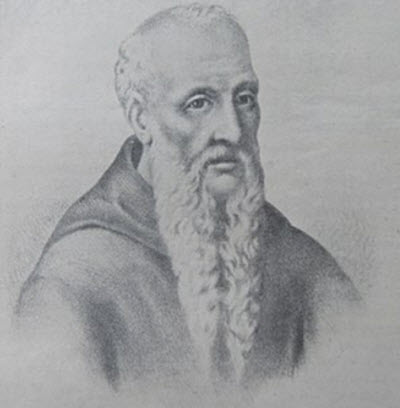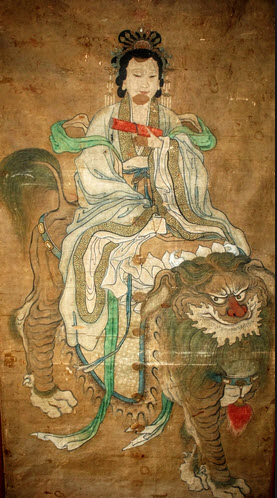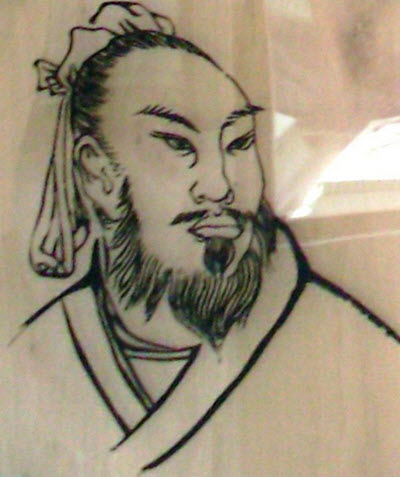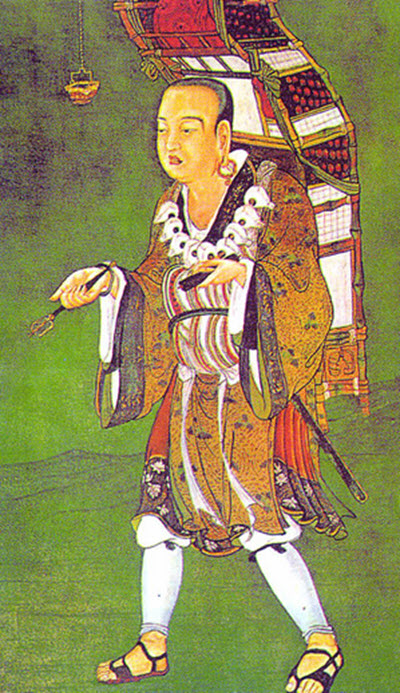Silk Road
14th century travelers on the Silk Road
Circa 1316-1330 AD: Odoric Mattituzzi from Pordeone

Odoric Mattituzzi (1286-1331) was an Italian Franciscian friar and missionary explorer who travelled to India and China.
Odoric journeyed via Constantinople and the Black Sea to reach Persia, and from there by ship to India in the early 1320s. In India, he embarked on a ship that took him around southeast Asia to the coast of China.
After living for several years in Beijing, Odoric travelled mostly overland to get back to Venice. He claimed to have gone through Tibet, but if this is actually true remains unclear.
Many of the marvelous stories included in John Mandevilles highly successful book “The Travels of Sir John Mandeville” are fanciful and embroidered tales based on Odoric’s texts.
1325-1354 AD: Shams al-Din Abu ‘Abd Allah Muhammad Ibn Battuta
This was an explorer of Tangier origin who travelled across North Africa, through Euroasia and all the way to China and back in 1325-1354. Afterwards, he dictated his experiences and knowledge to Ibn Djuzayy who wrote it down in the year 1354-1357. His tales from Anatolia, the lands of the Golden Horde, and southern India are considered especially valuable.
1339-1353 AD: Giovanni de’ Marignolli

This was a Franciscan from Florence who was sent by the Pope as a delegate to the Yüan (Mongol) Emperor of China.
Giovanni de’ Marignolli travelled through the Golden Horde lands via the Black Sea, and then onwards to Beijing and Shang-tu, arriving in August 1342. His exact route remains unclear, but it probably went south of the Aral Sea at Urgench and then north of the Taklamakan Desert.
After three years in China, Giovanni travelled onboard a ship to Hormuz and then overland to the Levant.
Travelers on the Silk Road before the year 1000 AD
Here are a few examples of people who travelled along the Silk Road prior to the year 1000 AD (CE). Most, but not all, of them are individuals who wrote about their journey and whose texts are considered to contain valuable historical and cultural information about the Silk Road.
The 900s BC: King Mu of Zhou

King Mu of Zhou
King Mu of Zhou was the fifth king of China’s Zhou dynasty, and he ruled either from 976 to 922 BC, or from 956 to 918 BC (sources vary). He travelled to places such as the Tarim Basin, the Pamir Mountains and what we today know as Iran. When he returned to his kingdom, he did so on the southern Silk Road.
2nd century BC: General Zhang (Chang Ch’ien)
The Chinese General Zhang first travelled the Silk Road in 138-125 BC, as an envoy of the Han Emperor Wudi. Wudi tasked Zhang with the job of recruiting the Yueh-chic people to an alliance against the Xiongnu. During his journey to reach he Yueh-chic, Zhang took the Northern Silk Road, skirting the Taklamakan desert and passing Pamir, before getting to Ferhana. Afterwards, he used the southern Silk Road to return to China.
General Zhang’s second trip on the Silk Road took place in 119-115 BC, when he was sent out to seek an alliance with the Wu-sun people. He travelled through places such ad Dunhuang, Loulan, and Kucha, before reaching the Wu-sun capital on the River Ili.
General Zhang’s journeys didn’t just have political impacts; they also helped open up China to trade with the west, especially Persia.
1st century AD: The author of the Periplus Maris Erythraen
At some point in 40-70 AD, a Greco-Roman merchant handbook was published containing plenty of information about trade routes involving East Africa, the Red Sea, and Asia as far east as India. It is focused on sea travelling, but would still be useful to many seeking to travel the Silk Road since it contains information about notable ports and trading hubs that tapped into to the same network. In these days, many merchants bringing eastern goods to the west and vice versa combined sea travel with land travel to find the best routes for their purposes.
This book was called “ Περίπλους τῆς Ἐρυθράς Θαλάσσης” in Greek and “Periplus Maris Erythraei” in Latin, which means periplus of the Eritrean Sea. To the Ancient Greeks, the term Eritrean Sea included both the Red Sea, the Persian Gulf and the Indian Ocean. A periplus is a manuscript document that lists the ports and coastal landmarks, in order and with approximate intervening distances, that a captain of a vessel can expect to find along a shore.
We don’t know who the author of this periplus was, and it is possible that the author compiled information from other travellers with extensive first-hand knowledge of the various areas rather than acutally doing all the travelling themselves. The manuscript was written in Koine Greek and it describes not just navigation but also trading opportunties along the Red Sea coast, the Horn of Africa, Pakistan’s Sindh region, and southwestern India. It is one of the prime examples of how much the Ancients of southern Europe knew about the lands around the Indian Ocean.
Most scholars agree that it was compiled around the middle of the 1st century AD, but some have suggested second or third century AD instead.
97 AD: Gan Ying (Kan Ying)

Gan Ying
This was the first Chinese envoy to the Roman Empire (known to the Chinese as Ta-Ts’in). Gan Ying was sent on this diplomatic mission by the powerful General Ban Chao, who was himself a well-travelled man with notable Silk Road experience. In the year 97 AD, Gan Ying travelled through the Pamir Mountains and Parthia, and all the way to what he called the Western Sea, which would have been either the Black Sea or the Parthian coast of the Persian Gulf. There, he was dissuaded from continuing westward by sailors who claimed that the journey by sea would take up to two years. This ment that he actally never reached Rome, but he still went further west than any other official Chinese envoy had gone before him.
399-413 AD: Fa-hsien (Faxian)
Fa-hsien was a Chinese Buddhist monk who travelled to India to learn more about the religion. He took the southern Silk Road, going through places such as Shensen, Dunhuang, and Khotan, before traversing the Himalayas to get to Gandhara, Peshawur and finally India. Fa-shien walked most of the time on his way to India, but on his way back to China he travelled by ship.
518-521 AD: Huisheng and Song Yung
In 518, the Chinese Empress Dowager sent a monk named Huisheng to India to obtain Buddhist scriptures for her. Accompanying the monk was Sung Yun of Dunhuang. The two men travelled through the Taklamakan Desert via the southern Silk Route, going though Shanshan, Charkhlik and Khotan, before reaching Hindu Kush, Kabul and Peshawar. The notes from their travels includes information about a visit to the kingdom of the Hephthalites.
629-645 AD: Hsuan-tsang (Xuan Zang)

This was a Chinese Buddhist monk and translator who travelled from China to India on the northern Silk Road, and then back home again on the southern route. He started in the year 629 and didn’t return to China until 645. Example of places that he passed through on his way to India are Turfan, Kucha, Tashkent, Samarakand, Bactria, and Hindu Kush.
Over time, the accounts of Hsuan-tsang’s travels grew into legends, which in turn inspired several novels and plays much later in history. The 16th century novel “Journey to the West” by Wu Ch’eng-en is one example.
713-741 AD: Hwi Chao
Hwi Chao was Korean Buddhist monk that grew up in China. In the early 8th century, he travelled by sea to India. He stayed abroad for several years, visiting Buddhist centers in India, Afghanistan and Persia. When it was time to go back to China, he went by land, passing through places such as Kashmir, Kabul and the Pamir Mountains. He entered Xinjiang from Tashkurgan, before skirting around the Taklamakan Desert.
Hwi Chao’s text “Wang wou t’ien tchou kquo tch’ouan” includes information about both Buddhist and Islamic populations living in Central Asia during this time period. Regretably, the original text disappeared at some point during the Tang Dynasty. In 1908, French explorer Paul Pelliot discovered an incomplete copy (approximately 6,000 words) of the book in a Dunhuang cave.
751-762 AD: Du Hwai
At the Battle of Talas in 751, the Arabs captured a Chinese soldier named Du Hwai and placed him in a prison camp. After ten years as a prisoner of war, Du Hwai travelled to Tashkent, Samarkand, Iran, Iraq, and Syria. In a port on the Persian Gulf, he boarded a ship and returned to China by sea. He wrote a book about his experiences and it contains a lot of information about life in Central Asia.
750-790 AD: Wukong
When Samarkand’s ambassador to China travelled home in 750, he was accompanied by a Chinese delegation that included a man named Wukong. In Samarkand, Wukong fell ill and could therefore not make the journey back to China when the rest of the delegation left. He eventually recovered, but instead of heading for China he became a Buddhist monk and lived in Gandhara and Kashmir. When he finally set foot in China again, it was in the year 790.
821 AD: Tamim ibn Bahr
Tamim ibn Bahr was a Muslim traveller and author who visited the Uyghur captial, located on the Orkhon River in present-day Mongolia. His exact origin remains a bit unclear, but he was probably from Khorasan. Regretably, his full travel manuscript has been lost, but an abridged version has survived into our time.
921-922 AD: Ahmad ibn Fadlan
The Abbasid Caliph sent Ahmad ibn Fadlan as ambassador to the Bulgars, a people inhabitig the middle Volga River area. To get there from Badhdad, the ambassador travelled through the Samanid state and Khwarezm, before continuing to the north of the Caspian Sea. His writings about the experience includes, among other things, observations from a Viking (Rus) funeral by the River Volga.
The Silk Road Facts for Kids

The Silk Road is a network of routes for traders. Because it is more than one, the Silk Roads have been used for more than 1,500 years.
The word “trade” also means the exchange of things between different countries. The trade network is called the Silk Road, but some historians call it the Silk Routes instead because it accurately shows how traders took many different paths.
The Silk Road is over 4,000 miles long. It goes across the Gobi Desert and the Pamir Mountains.
How did the Silk Road appear?
In the first century CE, silk became a problem. People were importing it from China, and the Romans were wearing it extravagantly.
Merchants had to take apart and reuse their silk to make it last longer. This made the silk clothes a very bad quality. The Roman Senate prohibited the use of silk.
This law did not last because people wanted silk, and trade over it was too important. Finally, roads to China helped to bring very good quality silk to Rome. To understand how we have to trace how silk got from China to Rome.
The Need for Heavenly Horses
The emperor of Han, Wu, had many wars with the people who lived in the land. These people were Xiongnu nomads, and they made trades grow.
Nomad horse riders have been raiding Chinese settlements for many years. Emperor Wu needed new horses for his army so he could beat the nomads.
Emperor Wu sent Zhang Qian to find allies in the fight against the Xiongnu nomads. Zhang went to Uzbekistan and saw horses that were hardy and strong, like something from heaven. The region also had rice, wheat, and grapes.
The Chinese people wanted to buy so many horses that they refused to sell any more. This led to a war also known as the War of the Heavenly Horses. The control of the horse zone opened a route to the West.
The Han Dynasty brought in horses to help them control the land. This led to an era of peace called Chinese Peace.
During this time, people in China had a better life. Cities grew in size, and economic growth led to more money. That meant that people could buy more expensive things from other places.
The Roman Expansion
The Roman empire was also expanding at this time. They got control of the western Mediterranean Sea after winning the Punic Wars. The Roman empire expanded, and they controlled all of the Mediterranean coasts by a few centuries later.
The first century CE is when the Roman Peace started. It lasted for about 200 years and was a time of a few wars.
In Han China, the people had political stability, and they could trade more. Rome traded with other countries and got goods from them.
The two empires of Han China and Rome were far apart. Central Asia has many mountains, vast deserts, and extensive grasslands. Traders helped connect the empires.
People in China made silk. Silk was taken to Rome. Both the Romans and the Chinese controlled many lands and kept them peaceful.
The Han people conquered central Asia. Then, traders who were nomads carried goods to the West or South. Trade brought new ideas, new faiths, and new goods to places they had not been before.
How was the Silk Road Traveled?
The trader’s camels helped them to carry their goods. Camels are good for traveling on land.
Camels are animals that can live in a desert because they have fur and can carry up to 500 pounds at a time. Camels made it possible to trade goods across the desert by carrying them, which made trading on the Silk Road possible.
There was no single government to take care of the roads. Robbers went around robbing people.
To protect themselves, traders joined together in groups. They had camels and other animals that they used to carry things. Large inns called caravanserais would receive a large number of travelers.
Few people traveled the full distance, so there were many middlemen and trading posts.
The oceans were also used to transport goods. Sailors need to understand wind and storms so they can successfully sail the ocean.
The Indian Ocean has winds that come from the northeast in winter and from the southwest in summer. Merchants were able to travel from the Red Sea in the summer to India.
Then they traveled back during winter. They shared information about this with other sailors, who then spread it everywhere.
Ports were on the coast of oceans, and they were necessary for trading. They could also get fresh water. The ships had trouble with fresh water, so it was a great way to get it.
Pirates were another risk in the Silk Roads. Pirates attacked ships because they had money.
People from Rome tried to avoid crossing into territory controlled by Parthians, their enemies. So the people take routes in the Silk Road to the north. They go across the Caucasus region and over the Caspian Sea.
The Silk Road had lots of rivers. Sometimes there was water, but sometimes the rivers went dry. This made it hard to trade over them. The Silk Road offered other routes to get to the same places easily.
What was Traded on the Silk Road?
More goods were available thanks to the Silk Road. Silk became a popular item because of its soft texture and how shiny it is. So people used silk as money in central Asia.
However, the process of making silk was a secret in China. It was only in China that people could make it.
This meant that trade goods traveled across Asia. There were many people and places involved in the Silk Road trade network.
Paper
Paper was invented in China by Cai Lun. He made it by cooking plants and water together. Then he pressed it and let it dry. Thanks to the Silk Roads, this technology of making paper would reach Europe in the Middle Ages.
The Compass
People in China knew about magnetite and how it behaves. They made the first compass with magnetite stones or needles that were suspended in air or water.
The compass reached Europe through the Silk Roads in the Middle Ages. The Italians were able to find their way because they turned it so that it pointed to where they wanted to go.
On the compass, you can find out which way is north and south and east and west. With a compass, sailors could count on an instrument that allowed them to orient.
The Printing Press
The first mechanical printing techniques were made in China. They used wooden plates on which they engraved the words, and there was a fast reproduction of fabrics and paper. Later, models of mobile devices were created that would later inspire the invention of the printing press.
The printing press was a new technology that was sent to Europe from Asia through the Silk Road. This invention changed the world because it helped people with learning, commerce, communication, and maps.
Gunpowder
Gunpowder was invented accidentally by Chinese alchemists or monks. They were working on heating some materials together with honey. Suddenly, there was smoke and fire that burned everything. When gunpowder was put in a container, it created an explosion because there was too much gas.
The Silk Road was the route that the explosive dust came through Asia. Gunpowder came to Europe. In the West, people used it for military reasons. They could make new weapons with it and more powerful ones too. This helped them take control of countries around the world in later years.
Other Goods and Ideas
People traveled on the Silk Road because they wanted to trade things like spices, beads that are made of glass, silk, ginger, and lacquerware. They also traded in furs from animals and slaves.
People who lived near the Silk Road had different religions and customs. They started to share ideas and beliefs. Towns along the Silk Road became interesting multicultural cities.
Marco Polo and the Silk Road
Marco Polo was a famous traveler from Italy. He went to China when he was 17 years old.
Marco Polo and his father traveled for 3 years before getting to Kublai Khan’s palace. Marco stayed at Khan’s court after he came back from Asia. He went on missions to places never visited by Europeans before.
When he came back, Marco wrote about his adventures, and this made him famous.
The Importance of the Silk Road

The exchange of information along the Silk Road gave rise to new technologies. These technologies changed the world.
Some things they brought to China were good. One thing was horses, and one thing was gunpowder. Having good horses helped the Mongolian Empire grow. Chinese gunpowder changed how people fought wars in Europe and beyond.
New diseases also traveled along the Silk Road. Some people say that the Black Death, which killed so many people in Europe during the Middle Ages, came from Asia. They think it got to Europe through the Silk Road.
The Age of Exploration gave people faster routes between the East and West. Parts of the Silk Road were still crucial for traveling among different cultures.
The Silk Roads were also very important for spreading religions. Buddhism traveled to many other countries, including the Silk Road countries. People there built Buddhist temples. We find them today in Afghanistan, China, and Indonesia.
Different religions spread along the Silk Roads. People traveled and picked up different cultures and beliefs as they went. These people then took these new things back to their countries with them.
People came to Indonesia and Malaysia with the Indian religion that is called Hinduism. People also came with Islam, which is from Arabia. They traveled the Silk Roads to get here.
Today, some parts of the Silk Road are on UNESCO’s World Heritage List.
Sources
P.S. If you enjoyed what you read and are a teacher or tutor needing resources for your students from kindergarten all the way up to high school senior (or even adults!), check out our partner sites KidsKonnect, SchoolHistory, and HelpTeaching for hundreds of facts, worksheets, activities, quizzes, courses, and more!
Source http://www.silk-road.com/newsletter/vol3num2/5_bloom.php
Source http://www.silk-road.com/artl/srtravelmain.shtml
Source https://historyforkids.org/the-silk-road/